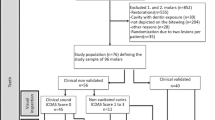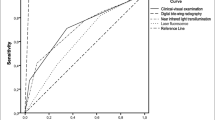Abstract
The aim of this in-vitro study was to compare the performance of laser-based (DIAGNOdent, KaVo, Biberach, Germany) and LED-based (Midwest Caries I.D., DENTSPLY Professional, New York, USA) caries detectors in the detection of occlusal caries in permanent molars. The study consisted of 129 visually sound or non-cavitated pits or fissures in 82 extracted permanent human molar teeth. Two trained examiners used the laser-based and LED-based caries detectors to examine the fissures for caries. The teeth were then sectioned at the surfaces suspected of containing occlusal caries and histologically evaluated using stereomicroscopy as a gold standard. Inter-examiner reliability of the caries detector examination was assessed using Cohen’s Kappa statistics. The sensitivity, specificity, and accuracy in diagnosing occlusal caries using the two devices were calculated according to appropriate cut-off scores. Receiver operating characteristic (ROC) curves were also determined to compare the diagnostic performance of the devices in occlusal caries diagnosis. The cut-off level of significance was taken as p = 0.005. Cohen’s Kappa showed substantial agreement for the laser-based caries detector (0.74), and almost perfect agreement for the LED-based (0.89) caries detector. The specificity of the laser-based device varied from 0.49 to 0.97 at T1 and T2. Its sensitivity varied from 0.33 to 0.65 at T1 and T2. The specificity of the LED-based device varied from 0.48 to 0.56 at T1 and T2. Its sensitivity varied from 0.65 to 0.84 at T1 and from 0.80 to 0.84 at T2. Taking the limitations of the current study into consideration, the DIAGNOdent laser pen was more accurate in determining when teeth were free of occlusal caries than was the Midwest Caries I.D. LED-based device, although the Midwest Caries I.D. device more often revealed the presence of occlusal caries than did the DIAGNOdent pen.


Similar content being viewed by others

References
de Paula AB, Campos JA, Diniz MB, Hebling J, Rodrigues JA (2009) In situ and in vitro comparison of laser fluorescence with visual inspection in detecting occlusal caries lesions. Lasers Med Sci 26:1–5
Bader JD, Shugars DA (2004) A systematic review of the performance of a laser fluorescence device for detecting caries. J Am Dent Assoc 135:1413–1426
Valera FB, Pessan JP, Valera RC, Mondelli J, Percinoto C (2008) Comparison of visual inspection, radiographic examination, laser fluorescence and their combinations on treatment decisions for occlusal surfaces. Am J Dent 21:25–29
Tranaeus S, Shi XQ, Angmar-Mansson B (2005) Caries risk assessment: methods available to clinicians for caries detection. Community Dent Oral Epidemiol 33:265–273
Rodrigues JA, Hug I, Diniz MB, Lussi A (2008) Performance of fluorescence methods, radiographic examination and ICDAS II on occlusal surfaces in vitro. Caries Res 42:297–304
Ricketts D, Kidd E, Weerheijm K, de Soet H (1997) Hidden caries: what is it? Does it exist? Does it matter? Int Dent J 47:259–265
Weerheijm KL, Kidd EA, Groen HJ (1997) The effect of fluoridation on the occurrence of hidden caries in clinically sound occlusal surfaces. Caries Res 31:30–34
Chong MJ, Seow WK, Purdie DM, Cheng E, Wan V (2003) Visual-tactile examination compared with conventional radiography, digital radiography, and DIAGNOdent in the diagnosis of occlusal occult caries in extracted premolars. Pediatr Dent 25:341–349
Carneiro LS, Nunes CA, Silva MA, Leles CR, Mendonca EF (2009) In vivo study of pixel grey-measurement in digital subtraction radiography for monitoring caries remineralization. Dentomaxillofac Radiol 38:73–78
Reis A, Mendes FM, Angnes V, Angnes G, Grande RH, Loguercio AD (2006) Performance of methods of occlusal caries detection in permanent teeth under clinical and laboratory conditions. J Dent 34:89–96
Heinrich-Weltzien R, Weerheijm KL, Kuhnisch J, Oehme T, Stosser L (2002) Clinical evaluation of visual, radiographic, and laser fluorescence methods for detection of occlusal caries. ASDC J Dent Child 69:127–132, 123
Heinrich-Weltzien R, Kuhnisch J, Ifland S, Tranaeus S, Angmar-Mansson B, Stosser L (2005) Detection of initial caries lesions on smooth surfaces by quantitative light-induced fluorescence and visual examination: an in vivo comparison. Eur J Oral Sci 113:494–498
Ketley CE, Holt RD (1993) Visual and radiographic diagnosis of occlusal caries in first permanent molars and in second primary molars. Br Dent J 174:364–370
Costa AM, Yamaguti PM, De Paula LM, Bezerra AC (2002) In vitro study of laser diode 655-nm diagnosis of occlusal caries. ASDC J Dent Child 69:249–253, 233
Pretty IA (2006) Caries detection and diagnosis: novel technologies. J Dent 34:727–739
Kuhnisch J, Bucher K, Henschel V, Hickel R (2007) Reproducibility of DIAGNOdent 2095 and DIAGNOdent pen measurements: results from an in vitro study on occlusal sites. Eur J Oral Sci 115:206–211
Kesler G, Masychev V, Sokolovsky A, Alexandrov M, Kesler A, Koren R (2003) Photon undulatory non-linear conversion diagnostic method for caries detection: a pilot study. J Clin Laser Med Surg 21:209–217
Farah RA, Drummond BK, Swain MV, Williams S (2008) Relationship between laser fluorescence and enamel hypomineralisation. J Dent 36:915–921
Kuhnisch J, Bucher K, Hickel R (2007) The intra/inter-examiner reproducibility of the new DIAGNOdent pen on occlusal sites. J Dent 35:509–512
Huth KC, Neuhaus KW, Gygax M, Bucher K, Crispin A, Paschos E, Hickel R, Lussi A (2008) Clinical performance of a new laser fluorescence device for detection of occlusal caries lesions in permanent molars. J Dent 36:1033–1040
De Benedetto MS, Morais CC, Novaes TF, de Almeida Rodrigues J, Braga MM, Mendes FM Comparing the reliability of a new fluorescence camera with conventional laser fluorescence devices in detecting caries lesions in occlusal and smooth surfaces of primary teeth. Lasers Med Sci 26:157–162
Lussi A, Imwinkelried S, Pitts N, Longbottom C, Reich E (1999) Performance and reproducibility of a laser fluorescence system for detection of occlusal caries in vitro. Caries Res 33:261–266
Shi XQ, Tranaeus S, Angmar-Mansson B (2001) Validation of DIAGNOdent for quantification of smooth-surface caries: an in vitro study. Acta Odontol Scand 59:74–78
Rodrigues JA, Diniz MB, Josgrilberg EB, Cordeiro RC (2009) In vitro comparison of laser fluorescence performance with visual examination for detection of occlusal caries in permanent and primary molars. Lasers Med Sci 24:501–506
Lennon AM, Buchalla W, Switalski L, Stookey GK (2002) Residual caries detection using visible fluorescence. Caries Res 36:315–319
Chu CH, Lo EC, You DS Clinical diagnosis of fissure caries with conventional and laser-induced fluorescence techniques. Lasers Med Sci 25:355–362
Diniz MB, Rodrigues JA, de Paula AB, Cordeiro Rde C (2009) In vivo evaluation of laser fluorescence performance using different cut-off limits for occlusal caries detection. Lasers Med Sci 24:295–300
Astvaldsdottir A, Tranaeus S, Karlsson L, Peter Holbrook W DIAGNOdent measurements of cultures of selected oral bacteria and demineralized enamel. Acta Odontol Scand 68:148–153
Kuhnisch J, Berger S, Goddon I, Senkel H, Pitts N, Heinrich-Weltzien R (2008) Occlusal caries detection in permanent molars according to WHO basic methods, ICDAS II and laser fluorescence measurements. Community Dent Oral Epidemiol 36:475–484
Strassler HE, Sensi LG (2008) Technology-enhanced caries detection and diagnosis. Compend Contin Educ Dent 29:464–465, 468, 470 passim
Lussi A, Hellwig E (2006) Performance of a new laser fluorescence device for the detection of occlusal caries in vitro. J Dent 34:467–471
Pitts NB (2004) Are we ready to move from operative to non-operative/preventive treatment of dental caries in clinical practice? Caries Res 38:294–304
Jablonski-Momeni A, Ricketts DN, Rolfsen S, Stoll R, Heinzel-Gutenbrunner M, Stachniss V, Pieper K (2011) Performance of laser fluorescence at tooth surface and histological section. Lasers Med Sci 26:171–178
Baelum V, Machiulskiene V, Nyvad B, Richards A, Vaeth M (2003) Application of survival analysis to carious lesion transitions in intervention trials. Community Dent Oral Epidemiol 31:252–260
Nyvad B (2004) Diagnosis versus detection of caries. Caries Res 38:192–198
Ricketts DN, Kidd EA, Wilson RF (1995) A re-evaluation of electrical resistance measurements for the diagnosis of occlusal caries. Br Dent J 178:11–17
Bader JD, Shugars DA, Bonito AJ (2002) A systematic review of the performance of methods for identifying carious lesions. J Public Health Dent 62:201–213
Ekstrand KR, Ricketts DN, Kidd EA (1997) Reproducibility and accuracy of three methods for assessment of demineralization depth of the occlusal surface: an in vitro examination. Caries Res 31:224–231
Umemori S, Tonami K, Nitta H, Mataki S, Araki K (2010) The possibility of digital imaging in the diagnosis of occlusal caries. Int J Dent. doi:10.1155/2010/860515
Author information
Authors and Affiliations
Corresponding author
Rights and permissions
About this article
Cite this article
Aktan, A.M., Cebe, M.A., Çiftçi, M.E. et al. A novel LED-based device for occlusal caries detection. Lasers Med Sci 27, 1157–1163 (2012). https://doi.org/10.1007/s10103-011-1020-0
Received:
Accepted:
Published:
Issue Date:
DOI: https://doi.org/10.1007/s10103-011-1020-0



